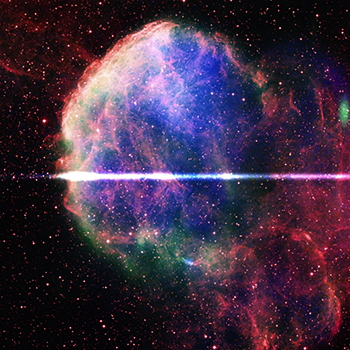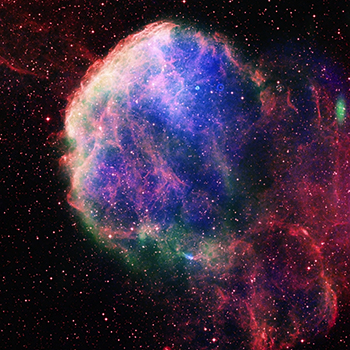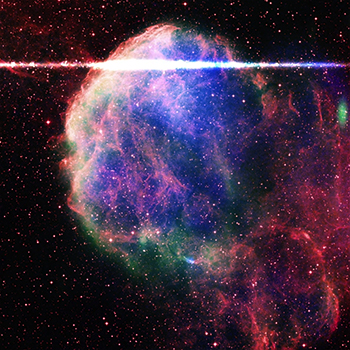
IC 443 (Jellyfish Nebula) Sonification
IC 443 is a supernova remnant, or the debris of an exploded star, which astronomers have nicknamed the Jellyfish Nebula. A visual composite image of IC 443 includes X-rays from NASA’s Chandra X-ray Observatory and German ROSAT X-ray telescope (blue) along with radio data from the NSF’s Very Large Array (green) and optical data from the Digitized Sky Survey (red). The sonification of IC 443 begins with a top-down scan as the brightness of the data is correlated to the volume of the sound. The sounds are mapped to colors in the image with red light being heard as lower pitches, the green as medium, and the blue light as the higher pitches. This creates notes that sweep up and down in pitch continuously. Several colors are isolated and control the volume of sustained tones with red controlling the lowest note and white controlling the highest note. The background stars in the optical image have been converted to water drop sounds in the sonification.
Access more information & file formats on this sonification
The Chandra sonifications were led by the Chandra X-ray Center (CXC), with input from NASA's Universe of Learning. The sustained collaboration was driven by visualization scientist Dr. Kimberly Arcand (CXC), astrophysicist Dr. Matt Russo and musician Andrew Santaguida (both of the SYSTEM Sounds project). For other sonifications, please see their linked pages.
cxcpub@cfa.harvard.edu
617-496-7941
60 Garden Street,
Cambridge, MA 02138 USA
Art Direction/Design: Kristin DiVona
Web Developers: Khajag Mgrdichian
& Kelly T.S. Williamson
Chandra X-ray Center, Operated for NASA by the Smithsonian Astrophysical Observatory. This site was developed with funding from NASA under contract NAS8-03060 | Privacy | Accessibility
Additional support from NASA's Universe of Learning (UoL). UoL materials are based upon work supported by NASA under award number NNX16AC65A to the Space
Telescope Science Institute, working in partnership with Caltech/IPAC, Jet Propulsion Laboratory, and Smithsonian Astrophysical Observatory.



